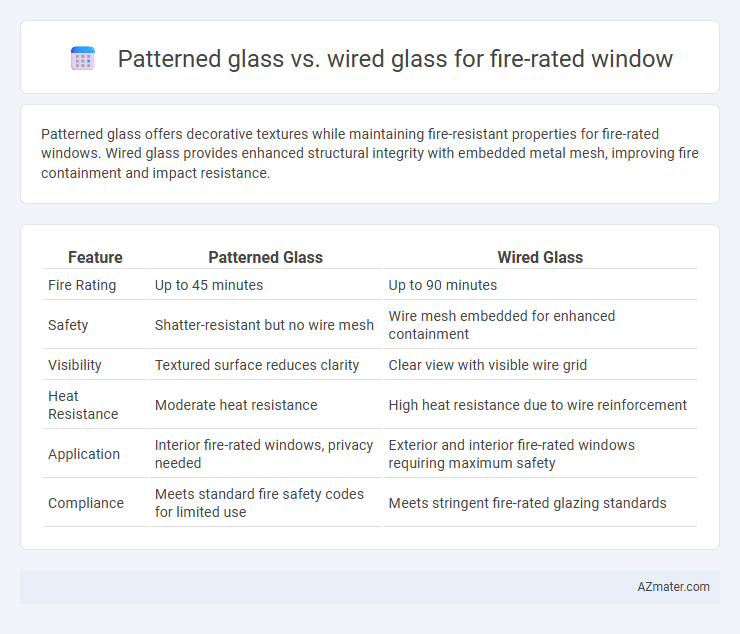Patterned glass offers decorative textures while maintaining fire-resistant properties for fire-rated windows. Wired glass provides enhanced structural integrity with embedded metal mesh, improving fire containment and impact resistance.
Table of Comparison
| Feature | Patterned Glass | Wired Glass |
|---|---|---|
| Fire Rating | Up to 45 minutes | Up to 90 minutes |
| Safety | Shatter-resistant but no wire mesh | Wire mesh embedded for enhanced containment |
| Visibility | Textured surface reduces clarity | Clear view with visible wire grid |
| Heat Resistance | Moderate heat resistance | High heat resistance due to wire reinforcement |
| Application | Interior fire-rated windows, privacy needed | Exterior and interior fire-rated windows requiring maximum safety |
| Compliance | Meets standard fire safety codes for limited use | Meets stringent fire-rated glazing standards |
Introduction to Fire-Rated Windows
Fire-rated windows featuring patterned glass provide enhanced aesthetic appeal while maintaining necessary fire resistance standards, allowing for controlled light transmission and privacy. Wired glass, embedded with a metal mesh, offers increased structural integrity during fire exposure by preventing glass shattering and fire spread. Both types meet fire safety codes, but patterned glass focuses on combining design with protection, whereas wired glass prioritizes fire containment and durability.
What is Patterned Glass?
Patterned glass is a type of textured glass designed with various surface patterns to enhance privacy while allowing light to pass through, making it ideal for fire-rated windows that require both safety and aesthetics. This glass provides limited visibility and diffuses light, offering a decorative but functional solution in fire-rated assemblies. Patterned glass meets fire safety standards by maintaining structural integrity and heat resistance similar to wired glass but without the embedded wire mesh.
What is Wired Glass?
Wired glass is a type of fire-rated glass embedded with a metal wire mesh that provides enhanced fire resistance and prevents shattering during high temperatures. This wire mesh helps maintain the integrity of the glass under fire conditions, making it a popular choice for fire-rated windows in commercial buildings. Compared to patterned glass, wired glass offers superior fire protection but may have limited visibility and aesthetic appeal.
Fire Resistance Capabilities: Patterned vs Wired Glass
Patterned glass offers limited fire resistance, primarily designed to provide privacy and decorative effects rather than withstand high temperatures or flames. Wired glass enhances fire resistance by integrating a fine metal mesh that holds the glass together during exposure to heat, preventing shattering and maintaining a barrier against fire and smoke spread. Fire-rated windows typically prefer wired glass for superior integrity and compliance with stringent fire safety standards.
Safety and Security Considerations
Patterned glass for fire-rated windows offers enhanced visibility and aesthetic appeal while maintaining safety through its ability to withstand high temperatures and contain fire spread. Wired glass incorporates embedded wire mesh that prevents shattering, providing added security against impact and structural failure during fires, although it may compromise visual clarity. Both materials meet safety standards, but wired glass generally offers superior resistance to intrusion and mechanical stress, making it preferable for areas requiring both fire protection and high security.
Aesthetic Differences and Design Options
Patterned glass for fire-rated windows offers a wide range of textures and decorative designs that enhance aesthetic appeal while providing privacy and light diffusion. Wired glass features embedded wire mesh, delivering an industrial, vintage look but limits design flexibility due to its uniform grid pattern. Designers favor patterned glass when seeking customizable styles, whereas wired glass suits projects prioritizing a rugged, safety-focused appearance.
Light Transmission and Privacy
Patterned glass for fire-rated windows offers moderate light transmission while enhancing privacy through textured designs that obscure visibility. Wired glass provides higher light transmission with clear visibility but offers limited privacy due to its transparent nature despite embedded wire mesh. Choosing between patterned and wired glass depends on balancing the need for natural light and maintaining privacy in fire-rated window applications.
Durability and Maintenance
Patterned glass offers moderate durability but can be prone to surface scratches and requires regular cleaning to maintain clarity, making it suitable for fire-rated windows where aesthetics are important. Wired glass provides superior durability due to its embedded wire mesh, which enhances structural integrity and prevents shattering under fire conditions, reducing maintenance needs over time. Both glass types meet fire safety standards, but wired glass generally demands less maintenance and offers longer-lasting performance in fire-rated applications.
Cost Comparison: Patterned vs Wired Glass
Patterned glass for fire-rated windows generally costs more than wired glass due to its decorative designs and manufacturing complexity. Wired glass is typically more affordable, offering basic fire resistance with embedded wire mesh but limited aesthetic appeal. Budget-conscious projects often prefer wired glass for cost savings, while patterned glass suits applications where both fire safety and visual design are priorities.
Choosing the Right Glass for Fire-Rated Windows
Patterned glass offers aesthetic appeal and diffuses light while maintaining fire resistance, making it suitable for fire-rated windows in design-sensitive spaces. Wired glass, embedded with metal mesh, provides enhanced structural integrity and prevents glass from shattering during fire exposure, meeting stringent safety codes. Selecting the appropriate glass depends on balancing fire protection requirements, visibility needs, and compliance with local fire safety regulations.

Infographic: Patterned glass vs Wired glass for Fire-rated window
 azmater.com
azmater.com